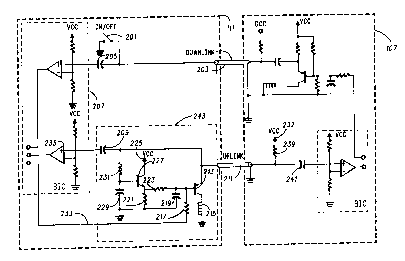Some of the information on this Web page has been provided by external sources. The Government of Canada is not responsible for the accuracy, reliability or currency of the information supplied by external sources. Users wishing to rely upon this information should consult directly with the source of the information. Content provided by external sources is not subject to official languages, privacy and accessibility requirements.
Any discrepancies in the text and image of the Claims and Abstract are due to differing posting times. Text of the Claims and Abstract are posted:
| (12) Patent: | (11) CA 2075835 |
|---|---|
| (54) English Title: | DATA BUS INTERFACE APPARATUS |
| (54) French Title: | INTERFACE DE BUS DE DONNEES |
| Status: | Expired and beyond the Period of Reversal |
| (51) International Patent Classification (IPC): |
|
|---|---|
| (72) Inventors : |
|
| (73) Owners : |
|
| (71) Applicants : |
|
| (74) Agent: | GOWLING WLG (CANADA) LLP |
| (74) Associate agent: | |
| (45) Issued: | 2001-05-08 |
| (86) PCT Filing Date: | 1992-02-20 |
| (87) Open to Public Inspection: | 1992-09-17 |
| Examination requested: | 1992-08-11 |
| Availability of licence: | N/A |
| Dedicated to the Public: | N/A |
| (25) Language of filing: | English |
| Patent Cooperation Treaty (PCT): | Yes |
|---|---|
| (86) PCT Filing Number: | PCT/US1992/001298 |
| (87) International Publication Number: | WO 1992016062 |
| (85) National Entry: | 1992-08-11 |
| (30) Application Priority Data: | ||||||
|---|---|---|---|---|---|---|
|
This patent application includes a description of a
data bus interface apparatus which interfaces between
one of a plurality of peripheral units (111) and a data bus
(109). The data bus interface driver (243) is capable of
biasing, data to the voltage level of the data bus (109),
accepting data signals (233) having different amplitudes
and is immune to differences in ground voltage
potentials caused by induced noise and differing
environmental conditions. The data bus interface driver
(243) is capable of data transition rates in excess of 1
MHz and has low EMI and RFI emissions.
La présente invention a trait à un dispositif d'interface de bus de données réalisant l'interface entre une multiplicité d'unités périphériques (111) et un bus de données (109). Le circuit d'attaque (243) d'interface de bus de données est capable de polariser les données au niveau de tension du bus de données (109), acceptant les signaux (233) de données ayant des amplitudes différentes tout en étant insensible aux différences de potentiels de tension à la terre causées par le bruit induit et la variation des conditions environnantes. Le circuit d'attaque (243) d'interface de bus de données est capable de cadences de transfert de données dépassant 1 MHz tout en produisant peu d'interférences électromagnétiques et de parasistes à haute fréquence.
Note: Claims are shown in the official language in which they were submitted.
Note: Descriptions are shown in the official language in which they were submitted.

2024-08-01:As part of the Next Generation Patents (NGP) transition, the Canadian Patents Database (CPD) now contains a more detailed Event History, which replicates the Event Log of our new back-office solution.
Please note that "Inactive:" events refers to events no longer in use in our new back-office solution.
For a clearer understanding of the status of the application/patent presented on this page, the site Disclaimer , as well as the definitions for Patent , Event History , Maintenance Fee and Payment History should be consulted.
| Description | Date |
|---|---|
| Inactive: IPC expired | 2015-01-01 |
| Inactive: IPC from MCD | 2006-03-11 |
| Inactive: IPC from MCD | 2006-03-11 |
| Time Limit for Reversal Expired | 2005-02-21 |
| Letter Sent | 2004-02-20 |
| Grant by Issuance | 2001-05-08 |
| Inactive: Cover page published | 2001-05-07 |
| Pre-grant | 2001-02-07 |
| Inactive: Final fee received | 2001-02-07 |
| Letter Sent | 2000-12-01 |
| Notice of Allowance is Issued | 2000-12-01 |
| Notice of Allowance is Issued | 2000-12-01 |
| Inactive: Approved for allowance (AFA) | 2000-11-20 |
| Amendment Received - Voluntary Amendment | 2000-10-12 |
| Inactive: Status info is complete as of Log entry date | 2000-09-11 |
| Inactive: Application prosecuted on TS as of Log entry date | 2000-09-11 |
| Inactive: S.30(2) Rules - Examiner requisition | 2000-06-16 |
| Application Published (Open to Public Inspection) | 1992-09-17 |
| Request for Examination Requirements Determined Compliant | 1992-08-11 |
| All Requirements for Examination Determined Compliant | 1992-08-11 |
There is no abandonment history.
The last payment was received on 2001-01-05
Note : If the full payment has not been received on or before the date indicated, a further fee may be required which may be one of the following
Please refer to the CIPO Patent Fees web page to see all current fee amounts.
| Fee Type | Anniversary Year | Due Date | Paid Date |
|---|---|---|---|
| MF (application, 6th anniv.) - standard | 06 | 1998-02-20 | 1997-12-31 |
| MF (application, 7th anniv.) - standard | 07 | 1999-02-22 | 1998-12-22 |
| MF (application, 8th anniv.) - standard | 08 | 2000-02-21 | 1999-12-14 |
| MF (application, 9th anniv.) - standard | 09 | 2001-02-20 | 2001-01-05 |
| Final fee - standard | 2001-02-07 | ||
| MF (patent, 10th anniv.) - standard | 2002-02-20 | 2002-01-07 | |
| MF (patent, 11th anniv.) - standard | 2003-02-20 | 2003-01-06 |
Note: Records showing the ownership history in alphabetical order.
| Current Owners on Record |
|---|
| MOTOROLA, INC. |
| Past Owners on Record |
|---|
| BERNARD L. KNYCH |
| JAYESH M. PATEL |
| JEFFREY W. TRIPP |